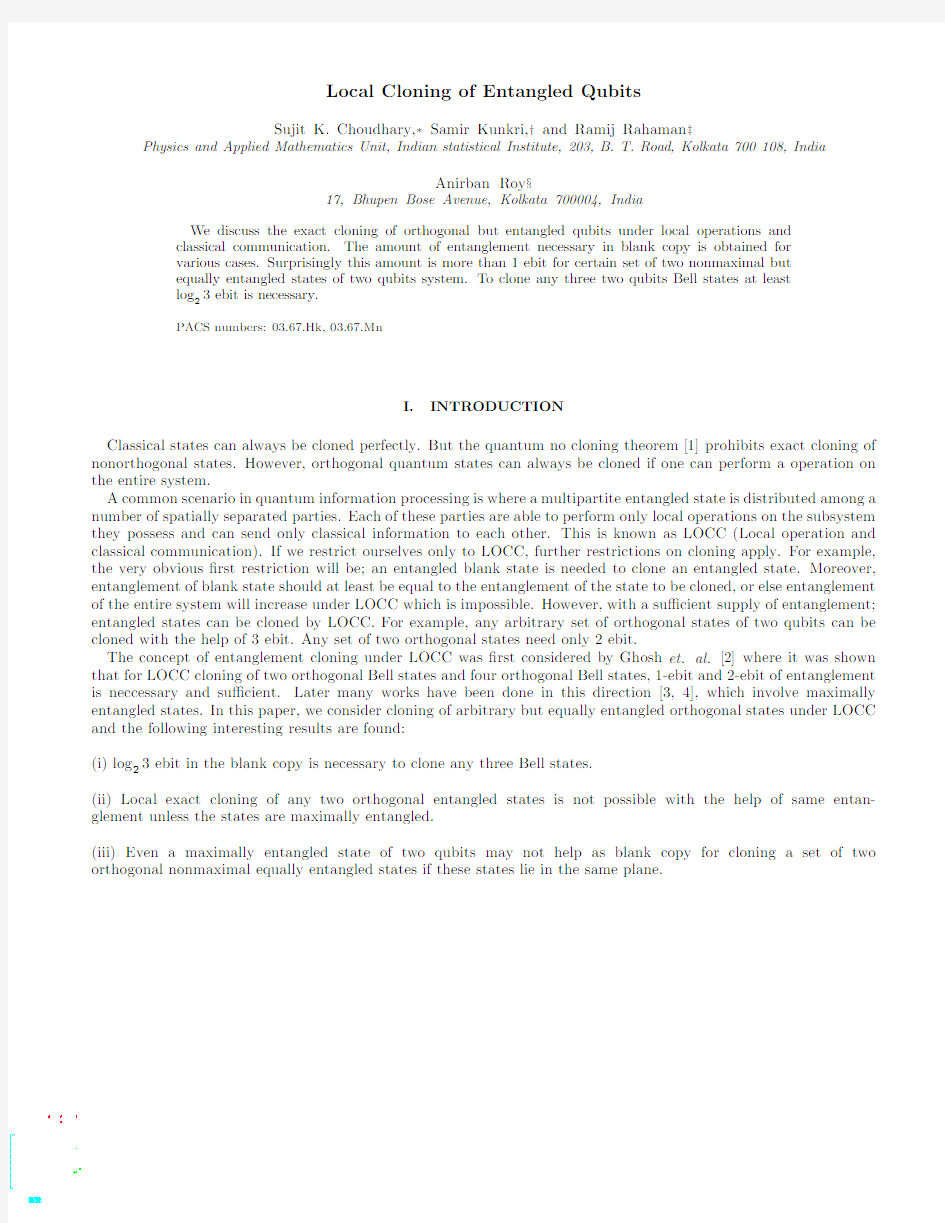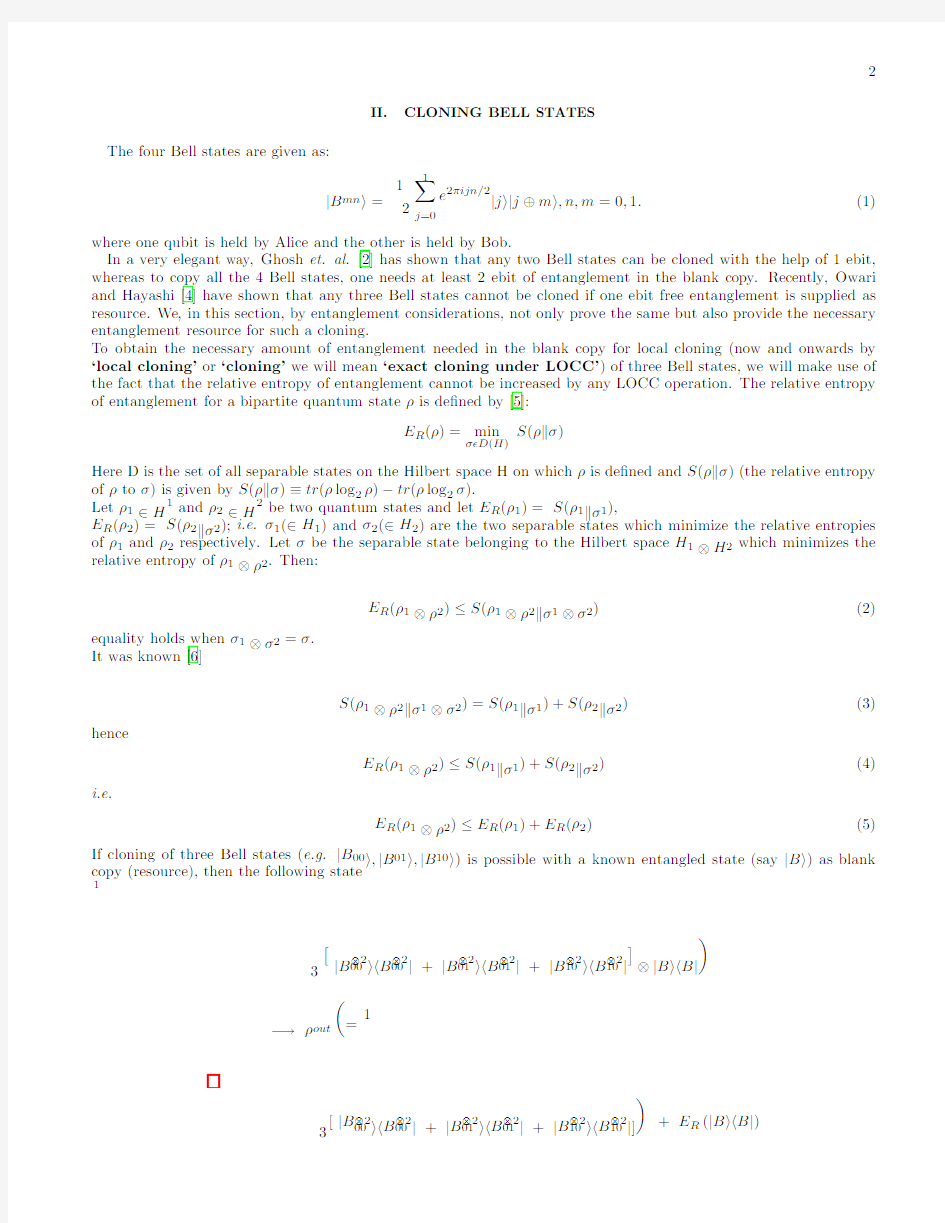

a r X i v :0706.2459v 2 [q u a n t -p h ] 6 J u l 2007
Local Cloning of Entangled Qubits
Sujit K.Choudhary,?Samir Kunkri,?and Ramij Rahaman ?
Physics and Applied Mathematics Unit,Indian statistical Institute,203,B.T.Road,Kolkata 700108,India
Anirban Roy §
17,Bhupen Bose Avenue,Kolkata 700004,India
We discuss the exact cloning of orthogonal but entangled qubits under local operations and classical communication.The amount of entanglement necessary in blank copy is obtained for various cases.Surprisingly this amount is more than 1ebit for certain set of two nonmaximal but equally entangled states of two qubits system.To clone any three two qubits Bell states at least log 23ebit is necessary.
PACS numbers:03.67.Hk,03.67.Mn
I.INTRODUCTION
Classical states can always be cloned perfectly.But the quantum no cloning theorem [1]prohibits exact cloning of nonorthogonal states.However,orthogonal quantum states can always be cloned if one can perform a operation on the entire system.
A common scenario in quantum information processing is where a multipartite entangled state is distributed among a number of spatially separated parties.Each of these parties are able to perform only local operations on the subsystem they possess and can send only classical information to each other.This is known as LOCC (Local operation and classical communication).If we restrict ourselves only to LOCC,further restrictions on cloning apply.For example,the very obvious ?rst restriction will be;an entangled blank state is needed to clone an entangled state.Moreover,entanglement of blank state should at least be equal to the entanglement of the state to be cloned,or else entanglement of the entire system will increase under LOCC which is impossible.However,with a su?cient supply of entanglement;entangled states can be cloned by LOCC.For example,any arbitrary set of orthogonal states of two qubits can be cloned with the help of 3ebit.Any set of two orthogonal states need only 2ebit.
The concept of entanglement cloning under LOCC was ?rst considered by Ghosh et.al.[2]where it was shown that for LOCC cloning of two orthogonal Bell states and four orthogonal Bell states,1-ebit and 2-ebit of entanglement is neccessary and su?https://www.doczj.com/doc/8f3185820.html,ter many works have been done in this direction [3,4],which involve maximally entangled states.In this paper,we consider cloning of arbitrary but equally entangled orthogonal states under LOCC and the following interesting results are found:
(i)log 23ebit in the blank copy is necessary to clone any three Bell states.
(ii)Local exact cloning of any two orthogonal entangled states is not possible with the help of same entan-glement unless the states are maximally entangled.
(iii)Even a maximally entangled state of two qubits may not help as blank copy for cloning a set of two orthogonal nonmaximal equally entangled states if these states lie in the same plane.
II.CLONING BELL STATES The four Bell states are given as:
|B mn =12
1
j=0e2πijn/2|j |j⊕m ,n,m=0,1.(1)
where one qubit is held by Alice and the other is held by Bob.
In a very elegant way,Ghosh et.al.[2]has shown that any two Bell states can be cloned with the help of1ebit, whereas to copy all the4Bell states,one needs at least2ebit of entanglement in the blank copy.Recently,Owari and Hayashi[4]have shown that any three Bell states cannot be cloned if one ebit free entanglement is supplied as resource.We,in this section,by entanglement considerations,not only prove the same but also provide the necessary entanglement resource for such a cloning.
To obtain the necessary amount of entanglement needed in the blank copy for local cloning(now and onwards by ‘local cloning’or‘cloning’we will mean‘exact cloning under LOCC’)of three Bell states,we will make use of the fact that the relative entropy of entanglement cannot be increased by any LOCC operation.The relative entropy of entanglement for a bipartite quantum stateρis de?ned by[5]:
E R(ρ)=min
σ?D(H)
S(ρ σ)
Here D is the set of all separable states on the Hilbert space H on whichρis de?ned and S(ρ σ)(the relative entropy ofρtoσ)is given by S(ρ σ)≡tr(ρlog2ρ)?tr(ρlog2σ).
Letρ1∈H1andρ2∈H2be two quantum states and let E R(ρ1)=S(ρ1 σ1),
E R(ρ2)=S(ρ2 σ2);i.e.σ1(∈H1)andσ2(∈H2)are the two separable states which minimize the relative entropies ofρ1andρ2respectively.Letσbe the separable state belonging to the Hilbert space H1?H2which minimizes the relative entropy ofρ1?ρ2.Then:
E R(ρ1?ρ2)≤S(ρ1?ρ2 σ1?σ2)(2) equality holds whenσ1?σ2=σ.
It was known[6]
S(ρ1?ρ2 σ1?σ2)=S(ρ1 σ1)+S(ρ2 σ2)(3) hence
E R(ρ1?ρ2)≤S(ρ1 σ1)+S(ρ2 σ2)(4) i.e.
E R(ρ1?ρ2)≤E R(ρ1)+E R(ρ2)(5) If cloning of three Bell states(e.g.|B00 ,|B01 ,|B10 )is possible with a known entangled state(say|B )as blank copy(resource),then the following state
1
3 |B?200 B?200|+|B?201 B?201|+|B?210 B?210| ?|B B|
?→ρout
=1
3[|B?200 B?200|+|B?201 B?201|+|B?210 B?210|]
+E R(|B B|)
As E R 1
Suppose there exists a cloning machine which can clone|Ψ1 and|Ψ2 when a pure entangled qubit state |Φ (=c|00 +d|11 ;c2+d2=1)is supplied to it as blank copy.Let us supply an equal mixture of|Ψ1 and|Ψ2 together with the blank state|Φ to it;i.e..the state input to the cloner is:
ρin= 12P(|Ψ2 ) ?P(|Φ )(6) The output of the cloner:
ρout=1
2
P[|Ψ2 ?|Ψ2 ](7)
For proving impossibility of such a cloner,we make use of the fact that Negativity,of a bipartite quantum stateρ, N(ρ)cannot increase under LOCC[10].N(ρ)is given by[11]
N(ρ)≡ ρT B ?1(8)
whereρT B is the partial transpose with respect to system B and ... denotes the trace norm which is de?ned as,
ρT B =tr(
a2b2(a2?b2)2
The above cloning will not be possible as long as,
cd<2a2b2+2
√
√
[P(|Ψ1 )+P(|Ψ3 )]?P[|Φ ]
2
We then have output of the cloner as:
ρout=1
2
P[|Ψ3 ?|Ψ3 ]
Putting for|Ψ1 |Ψ3 and|φ in the expression forρin andρout and making use of equations
(8)and(9),we get:
N(ρin)=2cd≤1
N(ρout)=2
2(a6b2+a2b6)(11) the above cloning is not possible.
(a)a=b=c=d=1
2turns this inequality into an equality.This again is consistent with[2].
(b)If we put c=a=d=b in the above inequality,i.e if we use same amount of entanglement(as in original states)
graph:
(c)Here too the inequality(10)shows that for any entanglement in the original states,except the maximally ones, the necessary entanglement in the blank copy is always higher.As an example,for a=
√
0.42,(i.e.entanglement of blank copy<0.9815),cloning is not possible.
IV.CONCLUSION
In this paper we addressed the problem of LOCC cloning for entangled states.To clone three Bell states,one need at least log23ebit in the blank state.So any two qubit state(pure or mixed)cannot serve this purpose.We have also shown the blank state needed should have more free entanglement than the original ones,for cloning any pair of nonmaximal but equally entangled orthogonal states.The necessary amount of entanglement in the blanck state for such cloning to be possible is given by inequalities(10)and(11).Interestingly this necessary amount is more than 1ebit for certain set of nonmaximal but equally entangled states contrary to certain other sets for which1ebit can serve as blank copy.
Acknowledgments
The authors acknowledge G.Kar for valuable suggestions.R.R acknowledges the support by CSIR,Government of India,New Delhi.
[1]W.K.Wootters and W.H.Zurek,Nature(London)229,802(1982);D.Diekes,Phys.Lett.92A,271(1982);H.P.Yuen,
ibid.113A,405(1986).
[2]S.Ghosh,G.Kar and A.Roy,Phys.Rev.A69,052312(2004).
[3]F.Anselmi,A.Che?es and M.Plenio,New J.Phys.6,164(2004).
[4]M.Owari and M.Hayashi,Phys.Rev.A74,032108(2006).
[5]V.Vedral and M.B.Plenio,Phys.Rev.A57,1619(1998);V.Vedral,M.B.Plenio,M.A.Rippin and P.L.Knight,Phys.
Rev.Lett.78,2275(1997).
[6]J.Eisert,eprint quant-ph/0610253and refernces therein.
[7]S.Ghosh,G.Kar,A.Roy,A.Sen(De)and U.Sen,Phys.Rev.Lett.87,277902(2001).
[8]The control-not operation C is de?ned as C|i ?|j =|i ?|j⊕i ,and the bilateral control-not operation(BXOR)de?ned on
bipartite system as,B is B|i A1|r B1?|j A2|s B2=|i A1|r B1?|j⊕i A2|s⊕r B2.Denote B(m,n)as the BXOR operation performed on the mth pair(source)and the nth pair(target),the following operation will give,B(1,3)B(2,3)|B?3mn = |B⊕3m,n [9].If this operation is applied onρout,one get1
|B?(2)
m,0